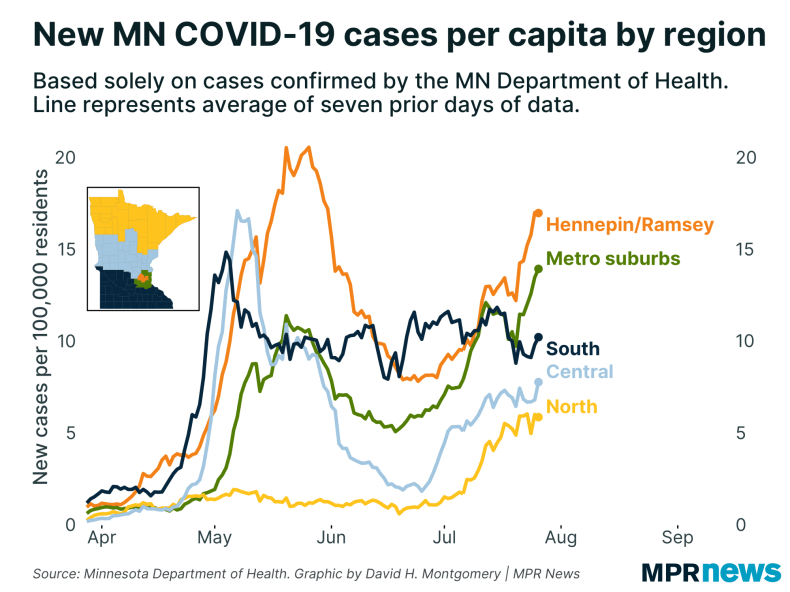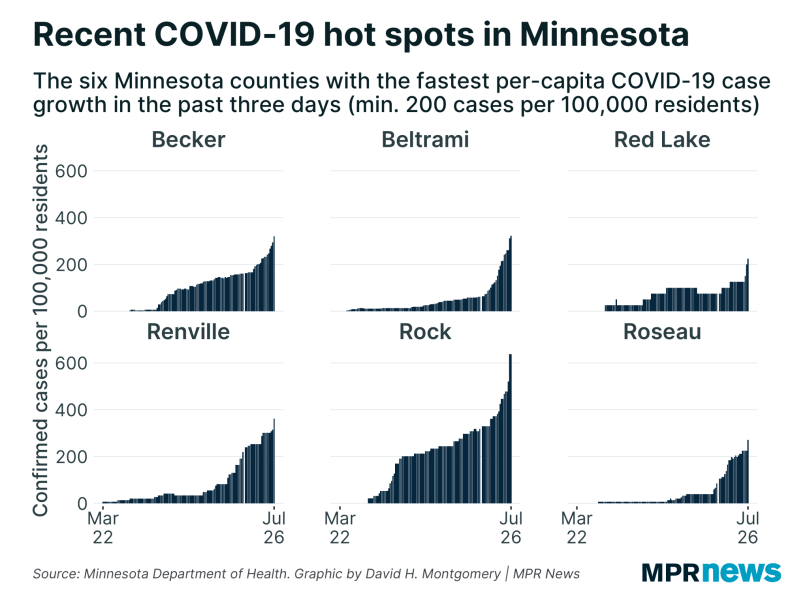That percentage had stayed below 5 percent for nearly a week — but Sunday’s report showed both an increase in the daily number of new, confirmed cases and a decrease in the number of completed tests, compared to Saturday.
While the overall statewide total stands at 51,153 cases, officials say limits on testing mean the actual number of cases is much higher.
Here are the latest coronavirus statistics:
- 51,153 cases confirmed (871 new) via 957,374 tests
-
1,574 deaths (three new)
-
4,920 cases requiring hospitalization
-
273 people remain hospitalized; 115 in intensive care
-
44,431 patients no longer requiring isolation
The newest numbers came a day after Gov. Tim Walz’s statewide mask-wearing order took effect, intended as a way to stem the spread of COVID-19 and put the state on a path back to normalcy.
If 90 to 95 percent of Minnesotans complied, businesses could stay open, kids could return safely to school buildings, and we “get back that life that we all miss so much,” he said.
Kris Ehresmann, the state’s infectious disease director, on Friday said it would be several weeks before officials could assess the impact of Minnesota’s new mask mandate.
“We kind of look at a 21-day window,” she said during Friday’s briefing. “We really are hoping, based on what’s been seen in other locations, that we’re going to see the positive impact of this mandate — but it won’t be instantaneous.”
Walz schools announcement this week
The governor is expected to announce a plan Thursday on bringing kids back into school buildings. The state Education Department has told school leaders to pretty much prepare for anything, including some combination of in-school and online instruction.
“Nobody wants kids in school more than me,” and state officials have been working for months on how to do that safely, Walz, a former high school teacher, said Tuesday.
“We’re doing everything possible to get those kids back in those classrooms … to keep them there but also have some nimbleness” to move back to an online or hybrid model if cases start to climb, he said, adding: “This is gonna be a challenge.”
The DFL governor has suggested in recent days that there won’t be a uniform order that will determine whether school buildings reopen. On KFGO radio Friday, Walz reinforced that local decisions are important and it’ll be up to school leaders to implement safety guidelines.
“It won’t necessarily look the same everywhere,” he said earlier this week, “but the outcomes need to be the same — kids and staff safe in that learning environment.”
Cases growing across age brackets, up north
State health officials continue to worry about the recent spike of coronavirus cases in younger Minnesotans, including that those infected will inadvertently spread the virus to grandparents and other more vulnerable populations.
Minnesotans in their 20s now make up the age group with the most confirmed cases in the pandemic, with more than 11,600. The median age of Minnesotans infected has been trending down in recent weeks and is now 36 years old.
Health investigators are now starting to see more cases in 30- and 40-somethings as more people get together for family gatherings and summer fun without social distancing, Ehresmann said earlier in the week.
It’s not the same as the situation the past few weeks where people in their 20s meeting in bars drove the increases. Now, analysts are seeing an evolution in the “larger, gradual increase in social activities,” she added.
On Friday, Ehresmann reiterated the point, urging people to take responsibility for wearing masks, social distancing and otherwise working to help stem the spread.
“Consider all the roles you play” in all daily interactions, she cautioned, noting that people who might not worry about themselves should worry about infecting vulnerable family members and coworkers.
Regionally, Friday’s newly reported cases were driven by the Twin Cities and its suburbs. The area is seeing both the most new cases and the fastest increases in growth rates.

New cases have also been rising in northern Minnesota.
Cases in Beltrami County, home to Bemidji, have more than doubled in the past week and a half, from 53 to 122 on Friday. That jumped again to 151 on Sunday.
Ehresmann this week said that case increase is tied to spread from athletic events and other public gatherings.
Meatpacking hot spots remain
Many of the outbreaks outside the Twin Cities metro area are focused around meatpacking plants. Officials have intensified testing in those hot spots, uncovering more infections.
That includes Mower County in southeastern Minnesota, where there were 1,038 confirmed cases as of Sunday. Mower County is home to Hormel Foods and Quality Pork Processors. Both have been partnering with Mayo Clinic to ramp up employee testing.
While some of Mower County’s positive cases are associated with people who work in the facilities and with the people they live with, county officials say they are also seeing transmission among people who live in the county but work in other counties where coronavirus is present.

Nobles, in southwestern Minnesota, reported 1,727 confirmed cases as of Sunday, with six deaths. About 1 in 13 people now have tested positive for COVID-19 in the county since the pandemic began, although the count of new cases has slowed considerably in recent weeks.
Worthington’s massive JBS pork processing plant was the epicenter of the Nobles outbreak. The JBS plant shut on April 20 but has since reopened with expanded hygiene and health monitoring measures.
Similar problems have been reported in Stearns County, where COVID-19 cases tied to two packing plants — Pilgrim’s Pride poultry plant in Cold Spring and Jennie-O Turkey in Melrose — skyrocketed in May. An undisclosed number of workers at both plants have tested positive for the virus.
There were about 55 confirmed cases in Stearns County in early May. By Sunday, confirmed cases were at 2,721 with 19 deaths.
Kandiyohi County in west-central Minnesota is also dealing with a significant caseload more than two months after officials with the Jennie-O turkey processing plant there said some employees had tested positive for the coronavirus.
As of Sunday, the Health Department reported 644 people have now tested positive. The county had confirmed three COVID-19 cases in late April.
Cases have also climbed noticeably in Lyon County (401 cases) around a turkey processor in Marshall.
Developments from around the state
Schools should remain in distance learning this fall, Twin Cities educators urge
Hundreds of Twin Cities teachers, staff, parents and students rallied at J.J. Hill Montessori School in St. Paul Friday to call for public schools to remain in distance learning unless the levels of coronavirus in Minnesota are dramatically improved.
Kimberly Caprini, a member of the Minneapolis Board of Education, called on Gov. Tim Walz to act and “provide the leadership that Washington won’t.”
“We are at an impasse in these frightening times,” Caprini said. “Protect our families. Protect our teachers. No return to in-person school until 14 days of no COVID-19 cases across the whole state.”
Greta Callahan, president of the teacher chapter of the Minneapolis Federation of Teachers and Education Support Professionals, spoke out against pressure for teachers to “step up” and teach in-person.
“Safety precautions alone are not enough,” said Callahan. “Why on earth would we go back and risk our lives for a system that has devalued and defunded public education for three decades?”
The teachers unions also are asking for policy changes to support the education of students of color. Walz is expected to make an announcement on schools Thursday.
— Emily Bright | MPR News
Riders may board from front door, pay by cash on Metro Transit buses starting August
Metro Transit says it will revert to some standard procedures it had abandoned when the coronavirus outbreak hit Minnesota.
Since mid-March, Metro Transit has required riders to board from the back of the bus to help protect drivers from possible virus contact. Front-door boarding and cash-fare collections will resume Saturday, said spokesperson Howie Padilla.
Padilla said new modifications are being made to protect drivers.
“What we’ve been able to do is create — and this was engineered out of our own maintenance staff — kind of plexiglass barrier, kind of what you’re seeing in some of the stores that we’re seeing through out the community but this was designed specifically to be installed on our buses,” Padilla said.
While it’s returning to cash-fare collections, Metro Transit is asking riders to use rider cards and electronic payments when possible, in order to limit contact. It’s also encouraging passengers to socially distance themselves from other public transit users.
— Mark Zdechlik | MPR News
Top headlines
Target to close on Thanksgiving, ending Black Friday kickoff: The move comes as stores are rethinking the Black Friday in-store bargain shopping as they try to curb the spread of the coronavirus, which has seen a resurgence in a slew of states. Walmart, the nation’s largest retailer, announced the move on Tuesday, and at the time, analysts expected more would follow.
COVID-19 brings surge of visitors — and some messes — to BWCA: The BWCA and the surrounding Superior National Forest in far northern Minnesota are seeing a surge in visitors this summer. That’s good news for the outfitters that rent equipment and lead trips into the area — but some of those campers are wreaking havoc on the pristine, protected region.
Aspiring lawyers balk at Minnesota bar exam over COVID-19 fears: Hundreds of aspiring lawyers are planning to take the Minnesota State Bar Exam this week despite concerns about COVID-19. The Minnesota Supreme Court denied a petition from nearly five dozen recent law school graduates who’d sought to have the test waived this year.
COVID-19 in Minnesota
Data in these graphs are based off Minnesota Department of Health cumulative totals released at 11 a.m. daily. You can find more detailed statistics on COVID-19 at the Health Department website.
The coronavirus is transmitted through respiratory droplets, coughs and sneezes, similar to the way the flu can spread.
